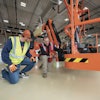Future transportation funding in Michigan will determine the conditions, safety and congestion levels of the state’s roads and bridges, as well as the economic health of the state and financial burden to Michigan households in the form of crashes, delays, bridge backlogs and vehicle operating costs.
A new report examines four possible transportation funding scenarios over the next decade, ranging from current levels and rates of investment (which are inadequate even to maintain the transportation system in its current condition) to an investment level capable of providing significant improvements in conditions and safety and significant reductions in congestion. The report, “Where Are We Going? Current and Future Pavement and Bridge Conditions, Safety, and Congestion Levels of Michigan’s Roadways and the Impact on Michigan Households, Based on Investment Levels over the Next Decade,” was issued by TRIP, a Washington, DC, based national transportation research organization.
While it will require a significant increase in transportation investment per Michigan household over the next decade to realize substantial improvements in the transportation system, these additional expenditures are more than outweighed by reduced costs associated with traffic crashes, congestion-related delays, bridge backlogs and additional vehicle operating costs as a result of driving on rough roads.
Inadequate roads, highways and bridges currently represent a financial burden to the average Michigan household of $3,014 annually in the form of traffic crashes, delays caused by traffic congestion, extra vehicle operating costs due to driving on rough roads, and in the cost to repair the state’s structurally deficient bridges. If the state continues to invest in its transportation system at the current funding levels, the TRIP report calculates that by 2022, the cost per household will rise to $3,649. However, if Michigan invests in roads and bridges at a level that would achieve a significant improvement in road and bridge conditions and performance, by 2022 the average annual household cost of inadequate roads, highways and bridges will decline to $1,745.
If the state continues to invest in its transportation system at the current funding levels, the TRIP report calculates that the annual cost for this investment from 2012 to 2022 will be an average of $303 per household. But if Michigan invests in roads and bridges at a level that would achieve a significant improvement in road and bridge conditions and performance, the average investment per Michigan household will be $1,122 annually from 2012 to 2022.
"By working smarter, doing things differently and reorganizing the department to create unprecedented efficiencies, the Michigan Department of Transportation (MDOT) has reduced spending by nearly $50 million," said MDOT Director Kirk Steudle. "We will continue to find ways to do more with less, but that will not change the need for new spending to rebuild the state's vital infrastructure system. The TRIP report's findings validate those facts and cast a spotlight on an economic development imperative."
Currently, 35 percent of Michigan’s major roads are rated in poor condition. If transportation funding remains at the current level, the share of Michigan’s major roads in poor condition will nearly double over the next decade, to 65 percent. At an investment level adequate to significantly improve the condition of major roads, the percentage in poor condition would decrease to just 14 percent by 2022.
Thirteen percent of Michigan’s bridges are currently structurally deficient and in need of repair, rehabilitation or replacement. Under current funding levels, the share of structurally deficient bridge will rise to 17 percent by 2022. But if adequate funding were made available to significantly improve bridge conditions, the share of structurally deficient bridges would be reduced to eight percent by 2022. The current cost to repair all structurally deficient bridges in Michigan is $1.4 billion. By 2022, bridges will have further deteriorated and the cost to repair them would rise to $2.2 billion. If funding were made available over the next decade to improve bridge conditions, the 2022 repair costs would decrease to $1 billion.
Highway safety can also be improved with additional transportation funding. Under current funding formulas, the number of traffic fatalities in Michigan from 2012 to 2022 is anticipated to be 7,955. If the state’s investment in roadway safety improvements was adequate to achieve significant safety improvements on these routes, it is projected that the number of traffic fatalities in Michigan from 2012 to 2022 would drop to 7,000 -- 955 fewer deaths than under current funding formulas.
In 2010, 31 percent of Michigan’s major urban roads and highways experienced congestion. Based on current levels of funding available for projects that would alleviate traffic congestion in Michigan, congestion levels over the next decade are projected to remain the same. However, Michigan could nearly eliminate congestion over the next decade if the state invested at a level needed to significantly improve traffic flow.
“Michiganders have an opportunity to literally decide where their state is going based on the transportation investment decisions made over the next decade,” said Will Wilkins, executive director of TRIP. “Michigan must decide whether its future will be one of well-maintained, safe and efficient roads, highways and bridges supporting the state’s economic recovery or a state of further deteriorated roads, highways and bridges, a less than optimal level of roadway safety, and a congested transportation system that is inadequate to support the state’s economic development goals.”


















